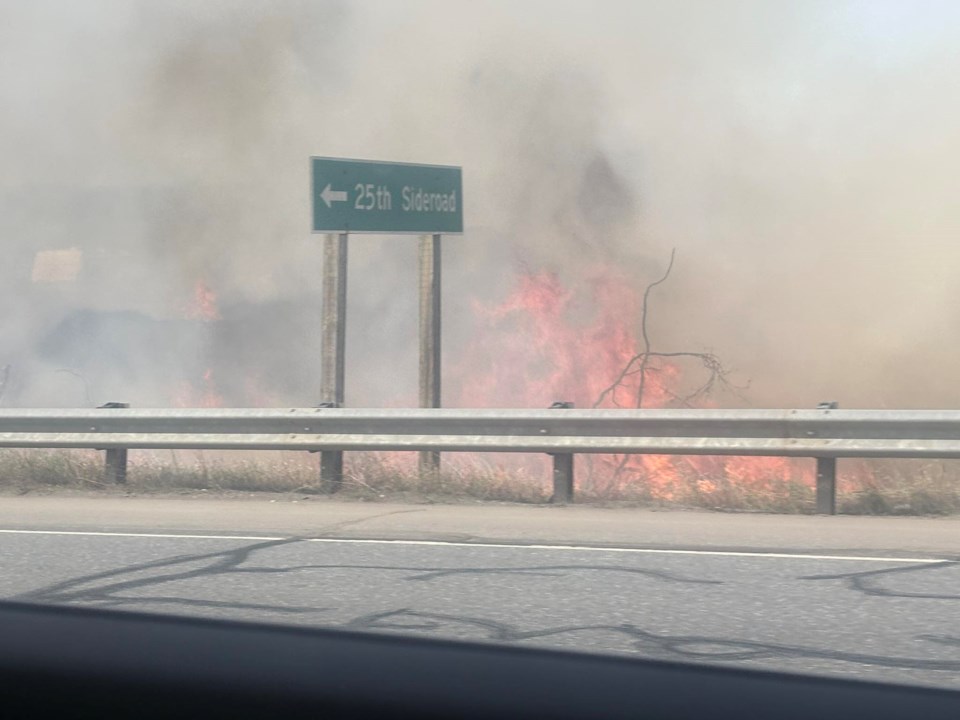THUNDER BAY — Investigators continue to probe the cause of several grass fires that erupted on the outskirts of Thunder Bay on Wednesday.
On Thursday, the Ministry of Natural Resources had a lead investigator on-site, assigned with the task of determining the cause of the blazes, which were reported along the CPKC train tracks the previous day around 3 p.m. They extended from the southwest of the Thunder Bay International Airport property and west into Oliver-Paipoonge.
“It was the absolute worst time of day really to have some kind of ignition source into that type of fuel,” said Thunder Bay deputy fire chief Dave Tarini.
“Along the railway right-of-way, there is a lot of dry, dead grass and fine fuels that will really carry the forward progress of the fire.”
The cluster of fires, now dubbed Thunder Bay 9 by the MNR, was listed as being seven hectares in size and mostly under control after receiving aerial suppression from CL-415 water bombers.
Tarini said large sections of the fire are already either contained or have been declared out.
“I can’t comment on some of the larger sections of the fire that are falling within the municipality of Oliver-Paipoonge, but the last information I received from the MNR was that the bulk of the fire is well in-hand and is not a concern at this point in time for the public and public safety,” he said.
It was a challenging situation, he added, but fire crews handled it extremely well.
“It was a very good effort from the responding pumper crews. When the fires are spread out over such a large geographical area, it presents a lot of challenges. It presents a difficulty for our dispatch who are receiving multiple calls about a variety of different locations to know where exactly to allocate the resources,” said Tarini.
“But we managed it quite well in the end. We received an extremely welcome cooperation from both the fire department in Oliver-Paipoonge and the Ministry of Natural Resources, which were absolutely essential in helping us have a positive outcome.”
Kevin Anderson, the captain of fire prevention and investigation with Thunder Bay Fire Rescue, said Oliver-Paipoonge supplied their water tankers to help resupply the trucks which were being used on the fires.
However, when the blaze got bigger, he said the MNR further helped with their water bombers.
“All working together, we were able to put those fires out without any damage to any structures,” said Anderson.
“So that’s the important thing — and no injuries. It’s a team effort and that’s what has to be done in these cases of grass fires (and) forest fires. So, everything went well as it could be expected.”
The fire risk is still relatively high due to the amount of dry grass on the ground and the relative lack of rain recently.
“Along the train tracks (is) a lot of dry grass, but when things do green up, then the risk lowers,” said Anderson, adding that they sometimes do controlled burns to try to prevent further wildfires.
Tarini said currently, Thunder Bay still does not have a fire ban in place.
“We’re in constant communication with the Ministry of Natural Resources in this area, the Thunder Bay fire management headquarters,” he said.
“We normally will follow suit with decisions that they make, according to their weather and fire behaviour data that they’re receiving, not only in the region but province-wide ... but we are constantly monitoring the situation.”
However, he said fire officials encourage anyone who has a burning permit, be it open burning or recreational, to follow the rules outlined on the document.
“Exercise extreme caution at all times when you’re using your permit or when you’re doing any kind of burning and make sure that you notify the local authorities through 911 or the Ministry of Natural Resources any time that you have any kind of situation that warrants us responding,” said Tarini.
- With files from Sheri Leviski-Kotyk.
